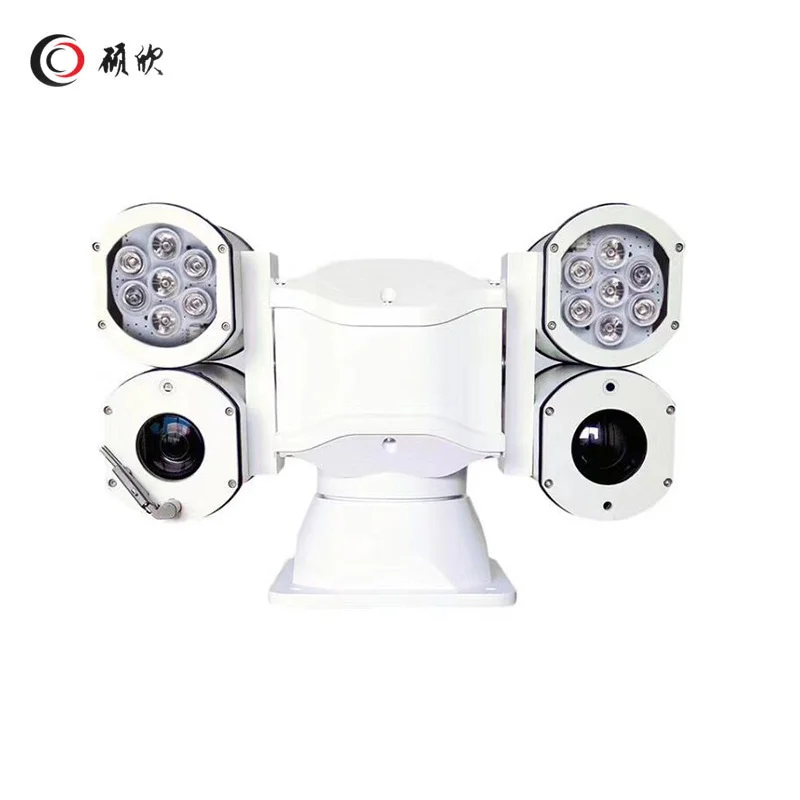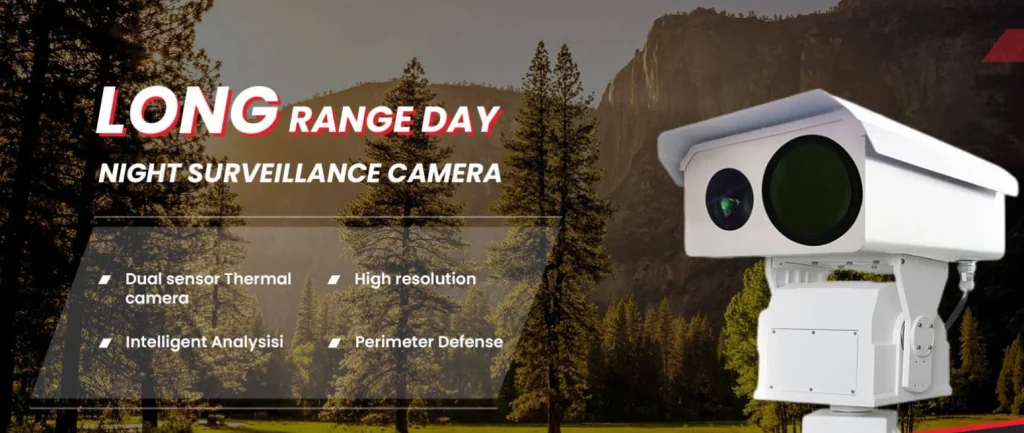Le telecamere PTZ a lungo raggio sono super importanti per la protezione dei confini. Tienono d'occhio luoghi grandi e lontani con precisione acuta. Queste telecamere ruotano da lato a lato, si inclinano su e giù e lo zoom è molto vicino. Gestiscono le condizioni meteorologiche difficili, vedono chiaramente al buio e utilizzano la tecnologia intelligente per trovare i pericoli. Collaborando con radar e AI, individuano rapidamente le minacce e osservano ampie aree. Queste telecamere di sicurezza funzionano senza problemi con i sistemi di controllo e brillano in luoghi difficili come spiagge, montagne o deserti. Rispetto alle normali telecamere, i modelli PTZ vedono più lontano, tracciano in modo intelligente e lavorano giorno o notte, rendendoli straordinari per la sicurezza delle frontiere.
Perché la sorveglianza è fondamentale per la sicurezza delle frontiere?
La necessità di osservare non-stop su grandi aree
Proteggere i confini è un duro lavoro. Si estendono per miglia, a volte migliaia di miglia. Questi luoghi possono essere deserti, boschi, colline o rive. Molti punti sono vuoti, quindi sono obiettivi facili per attraversamenti furbosi o contrabbando. Mandare gente a pattugliare ovunque è lento e difficile.
Ecco perché le telecamere PTZ a lungo raggio sono un grande problema. Mostrano un quadro chiaro e in diretta di ciò che sta succedendo. Con loro, puoi individuare i problemi presto. Lavorano tutto il giorno e la notte, inviando video per mantenere i confini al sicuro senza aver bisogno di persone ovunque.
Problemi nella protezione di zone di confine lontane e pericolose
I confini remoti sono difficili da proteggere. Si occupano di cattivo tempo, terreni sconvolti e notti buie. Spesso non c’è elettricità o internet. Le telecamere normali non sono grandi: non possono vedere lontano o girare. Le pattuglie richiedono molto tempo e non riescono a coprire tutto.
Per risolvere questo problema, hai bisogno di telecamere di sicurezza forti e intelligenti. I modelli PTZ a lungo raggio affrontano condizioni difficili e si regolano rapidamente. Sono fatti per continuare, non importa cosa.
Quali caratteristiche rendono una telecamera PTZ a lungo raggio ideale per la difesa di frontiera?
Le abilità Pan-Tilt-Zoom coprono ampie aree con il controllo Spot-On
Le telecamere PTZ si muovono intorno. Essi oscillano a sinistra e destra, ribaltano su e giù, e lo zoom stretto. Ciò consente a una fotocamera di osservare un'area gigante. Puoi rintracciare le cose in movimento, come persone o camion, attraverso campi o colline senza perderle.
A differenza delle telecamere fisse, i modelli PTZ ti consentono di concentrarti su un punto mentre vedi l'intera scena. Ciò li rende perfetti per confini.
Big Zoom mostra dettagli chiari da lontano
Vedere lontano è molto importante. Le telecamere PTZ hanno un forte zoom ottico. Possono concentrarsi su cose a miglia di distanza e ancora dare immagini chiare. Puoi individuare un'auto o una persona molto prima che si avvicinino.
Immagini nitide aiutano le guardie di frontiera ad agire rapidamente. Ciò riduce gli errori o gli allarmi sbagliati.
Visione notturna e funzioni Dim-Light mantengono la vigilanza 24 ore su 24

Le frontiere hanno bisogno di protezione anche di notte. Le telecamere PTZ utilizzano l'infrarosso (IR) per vedere nel buio totale. Prendono il calore dalle cose, quindi non è necessario alcuna luce. Hanno anche parti speciali per condizioni di buio, come nebbia o notti.
Questi trucchi significano che le telecamere non si fermano mai, mantenendo i confini al sicuro tutto il tempo.
Costruzione robusta e resistente alle intemperie Luoghi difficili
I confini possono essere grossolani sull'ingranaggio. Pensa al calore ardente, al freddo ghiacciato, alla polvere o alla pioggia. Le telecamere PTZ sono resi duri. Essi hanno Classificazioni IP66Così acqua e polvere rimangono fuori. Costruiti con materiale resistente alla ruggine, durano per anni in condizioni difficili.
Questa forza li mantiene al lavoro, indipendentemente dal tempo.
Come gestiscono queste telecamere le esigenze del mondo reale?
Superba sorveglianza di frontiera realizzata per le migliori prestazioni
Per soluzioni affidabili e moderne, Shuoxin costruisce ottime telecamere di sicurezza per i confini. Le loro fotocamere includono tipi a doppio sensore. Questi mescolano l'immagine termica per la notte e la luce visibile per il giorno. Questa combinazione funziona in qualsiasi luce, rendendoli pratici.
La collaborazione con Radar migliora la ricerca delle minacce
Queste telecamere di sicurezza si abbinano ai sistemi radar. Il radar nota il movimento, poi dice alla telecamera di guardare lì. La fotocamera si ingrandisce e segue il bersaglio. Questo lavoro di squadra abbassa i falsi allarmi e aiuta le guardie ad agire rapidamente.
Il tracciamento intelligente individua i pericoli senza ritardi
L’AI rende queste telecamere intelligenti. Si bloccano sulle cose in movimento e le tracciano da soli. La fotocamera oscilla, si inclina e zooma da sola. Ciò risparmia tempo e riduce gli errori, poiché nessuno ha bisogno di guidarlo tutto il tempo.
Quali sono i vantaggi di queste telecamere?
Il video in diretta aumenta la consapevolezza ovunque
Il video in diretta mostra ai centri di comando cosa sta succedendo in questo momento. Che si tratti di qualcuno che si nasconde o di una strana attività vicino a un punto chiave, lo vedi immediatamente.
Con queste informazioni, i leader possono inviare aiuto velocemente dove è più necessario.
Vista a 360 gradi riduce i punti nascosti
Le telecamere PTZ girano in giro. Coprono ogni angolo, quindi non manca nulla. A differenza delle telecamere normali, hai bisogno di meno di loro per guardare una grande area. Ciò risparmia denaro e rende il sistema più solido.
Gli allarmi automatici accelerano le mosse di emergenza
L’IA in queste telecamere individua attività strana, come qualcuno in una zona no-go. Invia immediatamente gli avvisi. Ciò significa che le guardie non hanno bisogno di guardare gli schermi tutto il giorno. Possono concentrarsi sulla recitazione, non solo sul guardare.
Come impostare le telecamere per ottenere i migliori risultati?
Posizionamento intelligente in punti a rischio offre viste chiare
Posizionare le telecamere in aree chiave come fiumi o sentieri di montagna. I punti alti, come le colline, danno la migliore vista. Pianifica bene in modo che ogni fotocamera copra una grande area senza lacune.
Un buon posizionamento garantisce che nessun punto rimanga invisibile.
Potenza costante e Internet sono chiave
Telecamere PTZ hanno bisogno di energia e dati per funzionare. In luoghi lontani, i pannelli solari con batterie sono comuni. Per i dati, utilizza cavi o wireless come LTE/5G, a seconda del luogo.
Senza energia o internet, anche la migliore fotocamera è inutile.
La connessione con i sistemi di controllo rende il lavoro più facile
Queste telecamere dovrebbero collegarsi facilmente con la configurazione dei comandi. Gli operatori possono vedere i feed su uno schermo, utilizzare mappe, segnare eventi o addirittura aggiungere droni. Ciò rende la gestione delle frontiere più semplice e veloce.
Come si confrontano con le normali telecamere di sicurezza?
Più lontano raggiungere punti minacce prima
Le telecamere normali hanno raggi brevi e viste fisse. Le telecamere PTZ vedono miglia di distanza con forte zoom e parti in movimento. Questo consente di catturare i pericoli molto prima che raggiungano luoghi come i punti di controllo.
Strumenti AI taglia fuori il lavoro manuale
Le vecchie telecamere hanno bisogno che le persone guardino gli schermi tutto il tempo, il che è stancante. I modelli PTZ utilizzano l'IA per notare schemi, come incrociamenti furbosi. Alertano automaticamente le guardie, rendendo le cose più veloci e più facili, soprattutto durante gli orari di traffico.
Dove funzionano bene questi sistemi oggi?
L'osservazione costiera ferma le minacce marine
Le coste sono aperte al contrabbando o alle barche illegali. Le telecamere PTZ proteggono le rive, anche in nebbia, utilizzando sensori termici. Modelli a doppio sensore Shuoxin lavorare giorno e notte, mantenendo al sicuro i confini marittimi.
Montagne e deserti beneficiano di Long Zoom e Night Vision
Luoghi difficili come colline o deserti sabbiosi sono difficili da pattugliare. Le telecamere PTZ, impostate in alto, utilizzano l'immagine termica per vedere di notte. Osservano il movimento dietro le rocce o le dune, quindi non si perde nulla.
Come scegliere la fotocamera giusta per le tue esigenze?
Considera distanza, terra e necessità di luce
Prima di tutto, decidere quanto lontano deve vedere la fotocamera: 500 metri o due chilometri? Verifica se il terreno è piatto o collinare, poiché questo influisce su dove metterlo. Inoltre, pensa alla luce: hai bisogno di visione notturna?
Questi dettagli aiutano a scegliere la fotocamera di sicurezza giusta.
Scegli tra modelli termici, visibili o a doppio sensore
Se guardare di notte è la chiave, scegliere l'immagine termica. Se la chiarezza diurna conta di più, le telecamere a luce visibile vanno bene. Per entrambi, le telecamere di sicurezza a doppio sensore Shuoxin sono la scelta migliore, coprendo tutte le situazioni.
Montaggi personalizzati Aggiungi opzioni
Puoi impostare telecamere su torri, camion o persino droni. Il montaggio giusto li mantiene fermi, anche nel vento o durante il movimento. Ciò garantisce che mirano bene, indipendentemente da dove siano posizionati.
FAQ
Q1: Le telecamere PTZ a lungo raggio possono funzionare nel buio totale?
R: Sì. Molti hanno sensori infrarossi che catturano il calore, non la luce. Utilizzano immagini termiche per vedere nel buio completo, oltre a sensori a bassa luce per una maggiore chiarezza.
Q2: Perché i sistemi a doppio sensore sono migliori delle telecamere singole?
R: I modelli a doppio sensore combinano l'imaging termico per la notte e la scarsa luce con l'imaging a luce visibile per il giorno. Ciò li rende ottimi in qualsiasi luce o clima.
Q3: Come posso assicurarmi che le mie fotocamere coprino tutte le aree chiave senza sovrapposizione?
R: Controllare prima il terreno. Posizionare le telecamere in base alla loro portata, assicurandosi che le loro viste si sovrappongano un po '. Questo copre punti chiave come strade o fiumi senza lacune.


